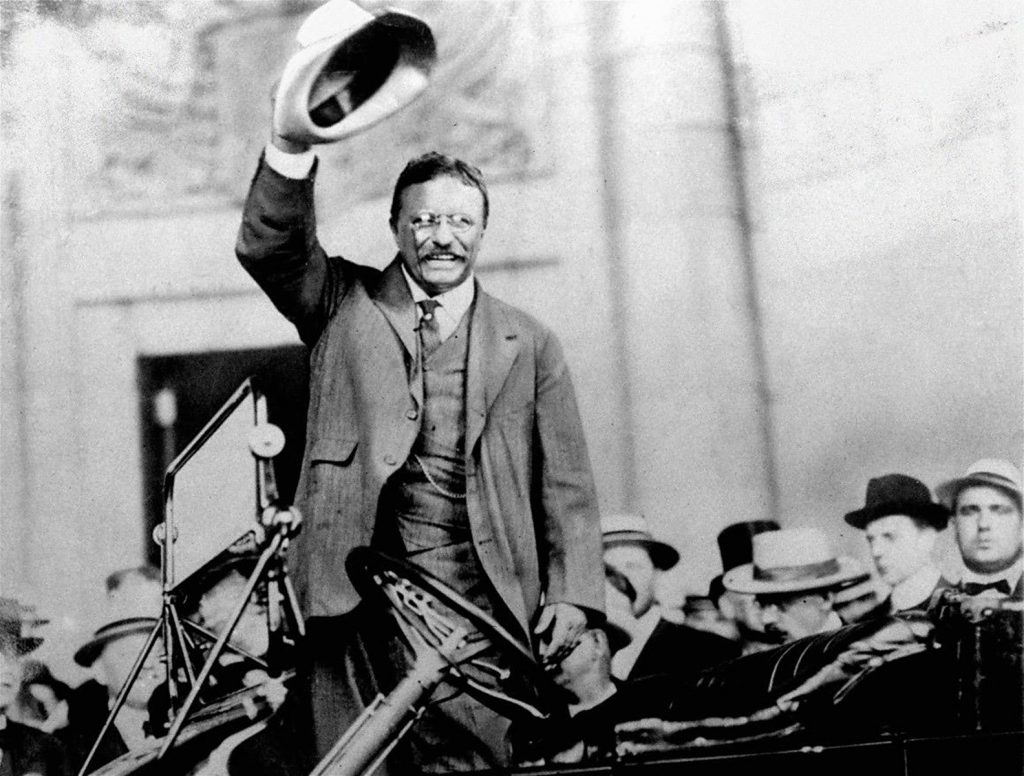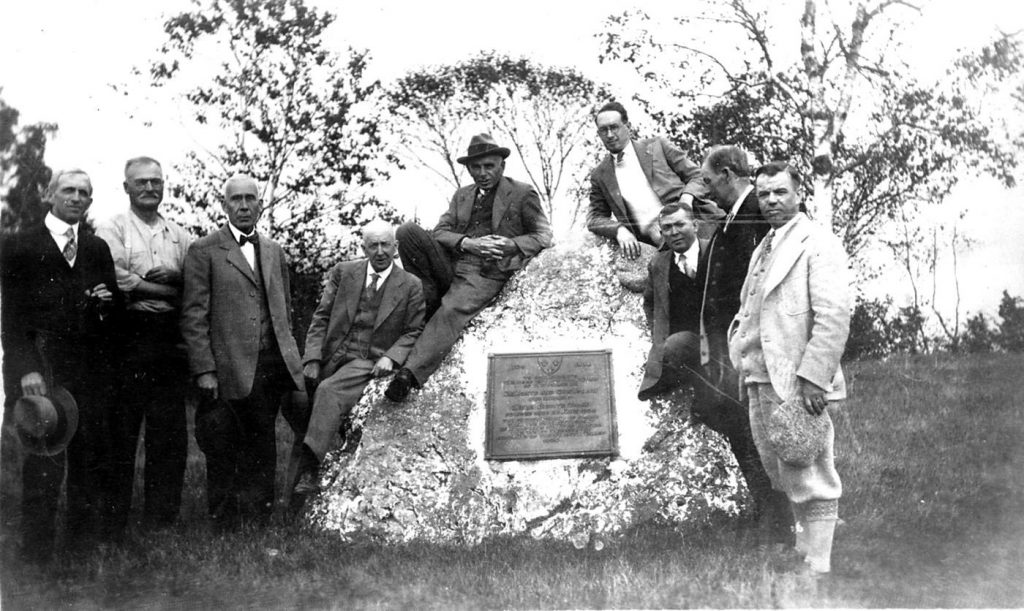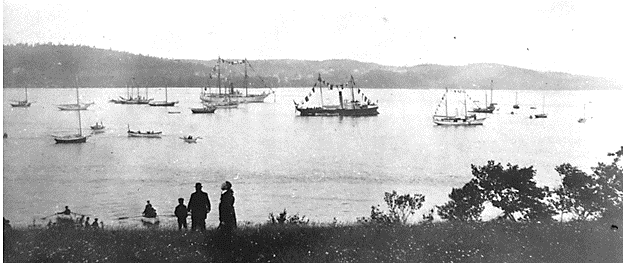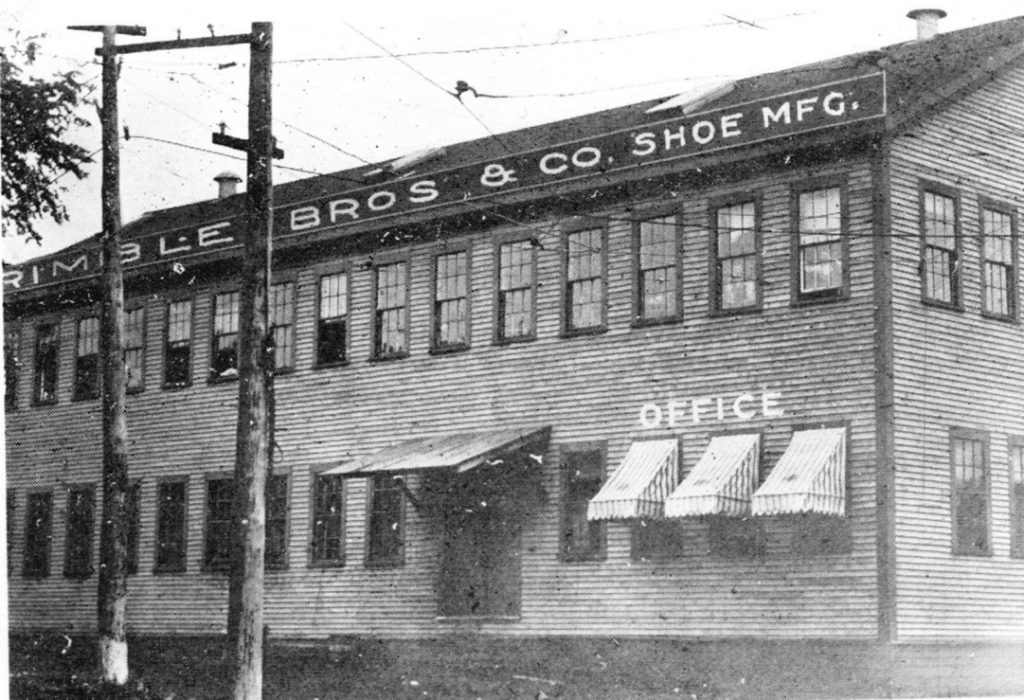
The world stage in 1904 featured only two main events—both involving our dynamic and controversial president, Teddy Roosevelt.
The photo above shows deliriously patriotic Japanese citizens sending their sons off to war against the Russians in early 1904. Tsar Nicholas of Russia had hoped to expand the Russian Empire in the Pacific, but his plans clashed with those of Imperial Japan over Manchuria. Nicholas believed Japan to be a feudal, weak and backward country unable to resist the mighty Russian Empire. He was proven disastrously wrong. The Japanese handily defeated the Russians in several land battles and sent nearly the entire Russian fleet to the bottom in the decisive naval battle of Tsushima Straits. The Russians had no choice but to sue for peace, and Teddy Roosevelt brought the parties to the table in Portsmouth, New Hampshire where the Treaty of Portsmouth ended the war on terms decidedly unfavorable to the Tsar. Roosevelt won the Nobel Peace Prize for his efforts. Japan, emboldened by its victory continued to expand its influence in the Pacific, and the Tsar continued to show atrocious judgement in ruling the Russian Empire and leading to his overthrow and execution, along with his entire family, just over a decade later.

From the day in 1901 when Vice-President Teddy Roosevelt was sworn in as President after the assassination of President McKinley, he was fixated on the Panama Canal. He strongly advocated that the U.S. take over the abandoned French effort to build the canal and in 1903 finally succeeded in purchasing the rights to the project from the French; and in 1904 he reached an agreement with the Panamanian government. Pictured above is a French dredge which had not been up to the task. American equipment and expertise proved somewhat superior to the French, but perhaps the main reason for the success of the American effort was a fellow named William Gorgas. The Canal Commission appointed Gorgas head of sanitation and hospitals, hardly a position one would think very important in such a vast engineering exercise. However during French effort 40,000 laborers and many French administrators had died of malaria or yellow fever on the canal project. Gorgas subscribed to the theory that these diseases were carried by mosquitoes, a theory not generally accepted in 1904. Nevertheless he spent vast sums of money on sanitation and the eradication of mosquitoes over the insistent complaints and objections of the bean counters. It worked, deaths from disease were only a small fraction of that of the French era and the canal was completed. Colonel Gorgas stands with Teddy as the two men most responsible for the completion of the Panama Canal.
In other interesting 1904 news the well-named Pope Pius X banned women from wearing low cut dresses in the presence of clerics, and the 4,607 mile Siberian railroad was completed. Its completion was a factor in Russia’s decision to wage war against Japan as the Tsar expected to resupply his troops over the line. This was another grave error in judgment as the railroad was beset with problems and trains were only rarely able to travel the entire route without breakdowns. Supplying an army was out of the question.

In 1904, Teddy Roosevelt was elected President in his own right. It was not much of a challenge. His opponent was Alton B. Parker, a New York jurist whose name was only slightly more familiar to voters then than it is today. In addition, Parker was an inept campaigner, conducting a “front porch” campaign rather than glad-handing his way around the country. Unfortunately the “front porch” from which he entertained a few curious voters with speeches on the gold standard was located in Esopus, New York, far up the Hudson River. Few made the trip and Teddy won in a landslide.
In other U.S. news New Year’s was celebrated in Times Square for the first time; ice cream made its debut, as did the legendary Ty Cobb; and the Boston Marathon was won with a time of 2 hours 38 minutes which today might put a runner in the top 2000. The Gillette safety razor was patented, and a woman was arrested for disturbing the peace for smoking in a car of Fifth Avenue in New York.

The big sports story of the year was the Dawson City Nuggets hockey team which by some strange process was selected to play Ottawa for the Stanley Cup. Dawson City is, of course, in the Yukon Territory, and it required several weeks of travel for the team to reach Ottawa— including at one point walking nine miles in the Yukon winter after completing a long dog sled journey. All this to reach Seattle to catch a train to Ottawa where they arrived somewhat depleted of athletic energy. They lost the first game 9-2 and the Cup after being defeated 23-2 in the second game of the three-game series. An Ottawa player, Frank McGee, scored 14 goals in the final which remains, not surprisingly, a Stanley Cup record. Then we suppose it was back to Dawson City and spring training for the next season.
In local news, Calvin Graves, who shot two game wardens in Wesley in 1886, was pardoned by the Governor and released from State Prison. Graves fled after the shooting as far as Anaheim, California where he would have been quite safe from the law had he not foolishly written home on regular basis. A relative was tempted by the $1000 reward for Graves and eventually told the authorities of Grave’s location. He was brought back to Calais in 1887 and lodged in the lockup on Union Street. Convicted at trial, he was given a life sentence.

The year 1904 saw the first internal combustion-powered car hit the streets (such as they were) of Calais. It was owned by George Murphy.


The previous year an electric car owned by George Curran, seen above, had taken to the streets but the electric car was not a success and soon Murphy’s gas car had a lot of company on the streets of the St. Croix Valley, although the “motor” or “horseless buggy” was at first more a nuisance to horses and a danger to streetcars than a viable alternative to either. The roads in 1904 were so rutted or muddy or both that motoring was a tribulation, not a pleasure.

In 1904 the 327-ton, three-masted schooner Vila y Hermano (Vila and Brother), launched at Calais by Rideout and Lord in 1891, made the passage from Havana to the outer bar at Mobile in fifty-four hours and established the record for sailing vessels. The Hermano, the last Calais vessel to come down the ways, classed A1 for fifteen years, measured 131.7’ x 31.3’ and had a draft of 10.5’. Her cabin was finished in hardwood, and the workmanship was described as excellent. She was to hail from Newport, Rhode Island, and was designed for the Gulf trade. For a time Captain Lord, one of the builders, owned some shares in her, as did the skipper, Captain John Clark of Perry. On 5 September 1905, while on passage from Havana to Pascagoula, Florida, she was run down and sunk. (From An International Community on the St. Croix [1604-1930] by Harold A. Davis)


In 1904 the tercentenary celebration of DeMonts’ and Champlain’s 1604 landing and settlement on St. Croix Island was observed. Many notable speakers from Canada, France, the United States and England addressed the large crowd on the island and later at a ceremony in St. Croix Hall in Calais. French and American warships were among the many boats and ships in the waters around the island. A monument was dedicated to the intrepid Frenchmen who braved the ocean and bitter winter on the island. The bodies of many of them are still interred on the south end of the Island, the victims of cold, starvation and scurvy. The plaque on the monument reads as follows:

THE DISCOVERY AND OCCUPATION
OF THIS ISLAND BY
DEMONTS AND CHAMPLAIN
WHO NAMING IT
L’ISLE SAINCTE CROIX
FOUNDED HERE 26 JUNE 1604
THE FRENCH COLONY OF ACADIA
THEN THE ONLY SETTLEMENT
OF EUROPEANS NORTH OF FLORIDA
THIS TABLET IS ERECTED BY
RESIDENTS OF THE SAINT CROIX VALLEY
1904
According to Barrett Parker’s account, the plaque “ . . . remains as the one tangible evidence of the tercentenary celebration held under the auspices of the Maine Historical Society to dedicate the landing of the Sieur de Monts, the Royal Geographer Samuel de Champlain, and that band of courageous and hard-bitten adventurers who accompanied them. On the 25th of June, 1904, off the northern end of the island were anchored the U.S.S. Detroit, Captain Dillingham; the French cruiser Troude, Captain Aubry; and M.S. Columbine, Captain Hill. A tent had been erected and several notable speeches were made to the hundreds who were present. In the concluding exercises conducted in the St. Croix Opera House in Calais, Dr. William Ganong, a distinguished authority on the history of the island, said in the course of his speech: ‘. . . We celebrate today not only an event of great human interest, but one of the momentous circumstances of history, the actual first step of North America from barbarism over the threshold of civilization, and the first stage in the expansion of two of the most virile races of Europe into the wonderful New World.’”
In other 1904 local news the Bank of Nova Scotia in St. Stephen notified its employees under 21 that they could not use tobacco. “The rule applies not only to office hours but is supposed to be adhered to at all times.” The St. Croix Paper company was formed to build a paper mill in Baileyville at Wapsnednegan, Passamaquoddy for “portage over rocks” and known locally as Sprague’s Falls. Construction began almost immediately with the importation of hundreds of Italian immigrants to the wilderness of Maine. Many stayed after the mill was completed and became leading citizens of the community we know as Woodland. The Maine Central took over the Washington County Railroad in 1904 and it became the Maine Central’s longest branch line.

John Johnson was elected mayor of Calais in 1904. Johnson operated a tannery on Steamboat Street, owned many very fast race horses, and was popular in town for, among other things, beating the Feds on a smuggling charge in Federal Court in Bangor. The Feds claimed Johnson took unfair advantage of his location on the river just a few hundred yards from Canada to smuggle large quantities of raw hides to his tannery. He returned from the Bangor trial rather a hero especially to his employees to whom he always insisted on paying a living wage regardless of market conditions.

The Trimble Brothers Shoe Factory on River Street was built and employed many locals for a little over a decade, but it burned to the ground during the First World War and was not rebuilt. However the Trimble Brothers continued to sell shoes in Calais on Main Street until the 1960s. This ad shows prices of footwear in 1955.

Granville Chase, the owner of the Chase Mills in Baring died leaving the mills to his sons Edward and Clifford who operated them until the 1930s when they sold out to the St. Croix Paper Company. Soon thereafter fire destroyed all the buildings leaving almost no trace of over 130 years of milling operations at Baring. On a happier note, Mary Boone, one of the three Boone sisters, was born.
The year 1904 was the year the famous Passamaquoddy seal nose scam was exposed. In those days there was a one dollar bounty on seals. This was collected by presenting the seal’s nose to the municipal authorities. The City Treasurer of Portland became suspicious of the number of seal noses on which he had been paying a bounty and when Louis Sapiel and Joe Dana of Pleasant Point arrived at his office with a sack of 84 seal noses in January 1904 he decided to investigate the noses very carefully. According to the article in the Portland paper he found that the noses weren’t noses at all “but manufactured articles composed of small pieces of seal fur, some fat and with some bristles stuck through them to pass for whiskers such as seals are abundantly provided with by nature.” The “noses” were, all admitted, very well crafted, but the game was up as Frank Atwen and Sabittis Newell of Pleasant Point learned the next day when they, not knowing the fate of their friends, arrived at the Portland City Treasurer’s Office with a sack of “noses.” An investigation established municipal offices all along the coast had been paying out large sums for noses; Freeport had laid out $200 just a few days prior. The seal bounty hunters were sentenced to 60 days in jail but not before they had done quite well for themselves in the seal nose business.

We’ll close with a photo of Calais’s firemen in 1904 in front of the Baptist Church on Church Street. Note the British flag. We believe this is a parade celebrating Queen Victoria’s birthday which like all celebrations in the St. Croix Valley in those days was an international affair.
